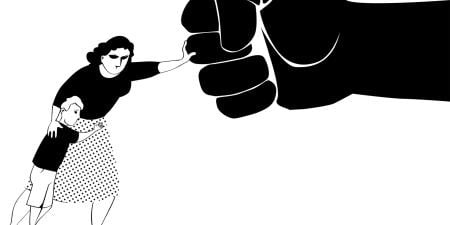Case
Three months of the first year of medical school had passed, and, in addition to the fields of anatomy and histology, Amanda was beginning to learn more about her classmates. She'd been pleased to discover that she had quite a bit in common with many of the students she'd met; like her, they not only had a fascination with human biology and pathophysiology but were also motivated to help others and to prevent or alleviate suffering.
When an e-mail went out to the first-year class announcing an upcoming visit by a military recruiter, Amanda assumed that her friends would agree that the military had no place in an academic institution dedicated to the promotion of health and the safety of individuals and communities. She was shocked to hear her lab partner say, "Actually, I'm in the Health Professions Scholarship Program. My husband and I have a young child, and putting us into debt for my education just wasn't an option. So, I'll do some military service after my residency, and the Army will cover the entire cost of med school. I don't see any conflict in being a military doctor. I'll make a huge difference by giving care to people who are working to keep us all safe and secure."
Commentary 2
When an individual has more than one professional role, the potential or possibility for strain among role obligations exists. In the case of military medicine, a physician is placed at a nexus of the profession of arms and the profession of medicine. Each of these professions has an ultimate end, or telos, with corresponding responsibilities and obligations. In the case scenario, Amanda asserts that the ends or goals of medicine and those of the military are incompatible. To oppose that view, one must look to the theoretical constructs and practical realities of both the professions.
The telos of a profession provides insight into the theoretical construct that shapes and influences the practical application of its values by its members. Should a conflict between the teloi of two professions exist, it might be said to create an inherent or intrinsic incompatibility. Such a situation would mean that anyone who attempted to negotiate the two at any given time would be necessarily in violation of at least one set of professional obligations. On the other hand, if it could be established that the teloi of the two professions were, at the very least, commensurate, then theoretically an individual could practice both without necessarily violating the professional obligations of either.
Are the ends ( teloi) of the profession of arms and the profession of medicine compatible? As described by Edmund Pellegrino, the telos of medicine may be broadly interpreted as "the right and good healing action taken in the interests of a particular patient" [1]. Extrapolating from the goal to its social obligations, physicians are charged with the promotion of health within society. The goal of the profession of arms, that is the profession that exists among soldiers who represent a legitimate government authority, is broadly the protection and safety of the society it serves. Both professions claim service to society as a telos, and both place self-sacrifice and the promotion of certain common values above personal gain and the pursuit of personal values and goals by practitioners.
Often what is called a conflict between professions is instead a conflict between professional demand and career demand within one profession rather than between professions. The prototypic professions (medicine, law, clergy, and academia) are dedicated to certain common goods and values that benefit society (i.e., health, justice, faith, and knowledge, respectively) and require that their members subordinate the pursuit of personal ends and values and adhere to certain objective standards and values. Careers, by contrast, are not necessarily governed by a set of unifying principles, values, or standards, but allow individual practitioners to pursue individual ends as long as they are within the bounds of respect for the rights of others; that is, one may not pursue personal gain indiscriminately at the expense of other individuals.
It is the pursuit of personal ends or goods versus the pursuit of a common good and the subordination of certain personal ends that distinguish professions from careers. At a theoretical level, both the profession of medicine and the military profession require members to subordinate certain personal ends and adhere to a certain set of objective standards contained within their professional code. Understood broadly, both professions' goals-the health, safety, and protection of society-are compatible.
While an inherent conflict does not exist when the professions are considered theoretically, the reality of practice may at times present overwhelming and potentially insurmountable obstacles and frustrations that necessitate the practical divorce of two professions. Two cases illustrate this point. In the first, the role obligations of the professions may become blurred to the point that the agent is unable to discern effectively which acts are proscribed by each profession. A physician in a noncombatant role in asymmetric warfare, for example, may not be able to tell whether it is more important to observe the immunity of an ambulance carrying opponent victims or to protect his or her troops from possible ambush by a weapon- or bomb-carrying guerilla fighter hiding in the ambulance. In the second case, role conflict may arise from the manner in which one or both of the profession is employed or embodied within specific circumstances. Many of these conflicts-of-circumstance are shared by military physicians and their civilian counterparts, e.g., whom to treat, allocation of scarce resources, complicity with actions that conflict with personal morality.
The difference for the military physician is that these conflicts take place within the context of combat and war. While few would object to the social good and necessity of a standing military for civil and national defense, there are those who might object to the means employed toward that end in particular instances. The military's means and activities might conflict with personal beliefs or moral standards. When this conflict occurs, it raises the question of how complicit that individual may be by his or her association with the military profession.
In the case of a military physician, the role is that of a noncombatant whose primary responsibility is the treatment and evacuation of wounded soldiers. The military physician plays no direct part in the aggression, though returning former patients to the fight is an indirect contribution to the war. This is an important distinction, since the intention of an agent (physician) imparts a moral character to his or her actions. The physician's intention is the restoration of health and the prevention of disease; it is not necessarily the intent of the physician that the aggression persists.
A parallel example can be found within the domain of civilian medicine. Individuals enter the profession of medicine with the intention of serving its proper goods and ends, desiring to help others and to act as instruments of health in society. Yet, for many, entry into the civilian medical profession is entry into a broken U.S. health care system that permits death and disabilities due to poor access to care. We do not, however, claim that physicians are therefore complicit with this often unethical distribution of health care simply by virtue of their participation in the profession of medicine. This example shows that material cooperation within a system-even one that conflicts with personal morality or the telos of the profession that it incorporates-does not necessarily invalidate or implicate the actions of individuals whose intentions are true to their profession.
Prioritizing the Conflicting Goals of Two Professions
So far I have argued that the ends of medicine and the military are not inherently incompatible, and that the practices of these professions are not necessarily incommensurate. When an individual (or group of individuals) works toward two distinct teloi, even commensurate teloi, the potential that their intermediate ends and goals will come into conflict is real. One can point to a number of conflicting intermediate examples, such as who is treated first, allied soldiers or injured hostile combatants? What means of triage should be employed? What is the extent to which a physician is a noncombatant? Is there a role for the physician within the realm of prisoner-detainee interrogation? How might one negotiate these conflicts?
One approach to resolving the conflicts requires a hierarchical structuring of goods that may be referenced when conflict occurs among them. Simply put, is the individual a solider first or a physician first? This is, in part, a personal consideration that must be reflected upon by all military physicians. At the same time, the axiological structuring of values is too important to be limited solely to the realm of personal reflection. It requires a broader discussion among all those who participate within this group; it should be discussed at the organizational level within the medical corps.
Another instance of conflicting intermediate goals may be useful in illustrating the point. Within the profession of medicine, we often speak of intermediate ends or goals, such as palliation of pain and suffering and the prolongation of life. These intermediary ends or goods are sought by the profession in the service of its telos (the right and good healing action taken in the benefit of a particular patient as the ultimate goal of the practice of medicine). There are times, however, within clinical care situations that the intermediate goals conflict, as in the case of an individual with multi-organ system failure. Here, it is possible to envision a point at which it is no longer medically feasible or personally preferable to pursue both intermediary goods, and thus the focus should be placed upon one or the other of them. Hospice might represent an example of such a transition point.
Within contemporary medical practice in the United States, the negotiation of these divergent goods is achieved by reference to the hierarchical structuring of values by the patient; that is, the patient, by reference to the values he or she holds to be important (and how they are hierarchically ranked), decides which intermediary end is to be sought. So, too, is the military physician called upon to rank hierarchically the intermediary goods of the profession of medicine and the profession of arms to resolve scenarios in which those goals conflict.
Amanda and the Military Recruiters
In the case we are presented, Amanda believes that military recruiters have no place in an academic institution devoted to healing and public safety. Her claim is most likely based in a belief that the profession of medicine and the profession of arms are either intrinsically or practically incompatible in their goals. While this may be a view of a significant minority in society, I have attempted to illustrate some of the main considerations that must be investigated in order to determine whether teloi and practical realities of the profession of medicine and the profession of arms are incommensurate. It has been my argument that indeed there appear to be no theoretical incompatibilities between the two professions and, while the potential exists for practical incompatibilities that necessitate reflection on the part of the individual physician and medical corps, these are not so insurmountable as to render the professions incommensurate. Rather, while the role the military physician embodies many unique challenges that require reflection and discernment, it presents the unique opportunity to practice medicine in the important capacity of caring for individuals who willingly and selflessly place their lives in harm's way in service to their country and its ideals.
References
- Pellegrino E. Toward a reconstruction of medical morality: the primacy of the act of profession and the fact of illness. J Med Philos. 1979;4(1):32-56.



